|
On returning from Africa at the end of 2004, we had lived in the truck for 9 months. We had a good idea of modifications and improvements to be made as well as fixes that were needed. The evolution continues. . .
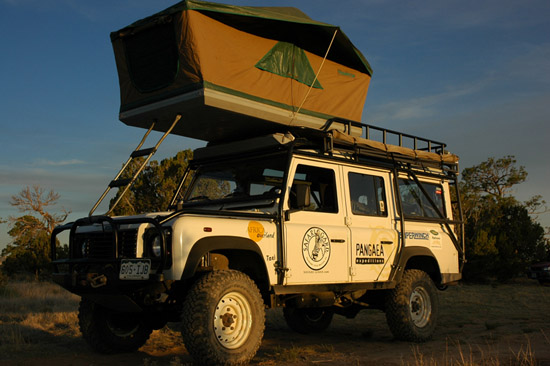
When originally installed, I had not aligned the rear tire rack correctly, and so it flexed the rear tub bodywork, eventually cracking it and taking out the rear light as well. I took the truck to SVE to get the tub repaired and to get the roof re-painted since storing the awning sides up there had removed a great deal of paint. SVE did a nice job on the painting and on the metalwork, but they failed to re-install a couple of roof seals, so I will have to remove the roof again later.
In Yaoundé we were driving past a restaurant when a guard lobbed a hunk of concrete at a dine-and-dasher. Unfortunately the concrete hit us in the rear quarter panel. It put a hole in the panel, and SVE was unable to fix it due to the severe metal warpage. So that scar will remain.

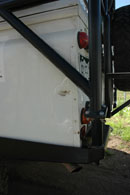
The indoor/outdoor thermometer we had used in Africa finally gave up the ghost. We got another generic unit to replace it, but really couldn't stand the fact that it flashed the time along with the temperature. Finally we setteled on getting an Engel unit that displays both fridge and outside temp as well as min and max attained values. And no flashing display!

Due to the 2.5" of lift and the increased suspension travel, the front prop shaft was running out of articulation at full suspension droop. Rather than exchanging it for a different unit, Keith at RoverTracks determined that we could file a small portion of metal out to allow the required flex.
In Africa we had maintained surprisingly good satellite connection with the GPS, but in some cases when we had lost connection, I felt an external antenna would have helped. I fitted a Garmin external antenna to the front hoop of the roll cage.
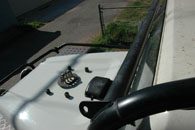
Since the steel mesh we got in Morocco was rusting and looking much the worse for wear, on my way back through England after the trip, I stopped to get the official headlight protection from Land Rover. These lexan covers are not cheap, but they do afford significant security to the headlights, and can be taken off easily to be cleaned.
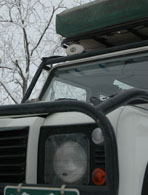
The Safari Gard Rock Gard had taken a massive hit in Mauritania that had bent the entire assembly and made it very difficult to adjust the track rod. Luckily it had done a fantastic job of protecting the track rod. I replaced the Rock Gard kit and stock track rod with a heavy duty high clearance track rod from RoverTracks.
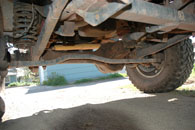
The 4-way lug wrench we used in Africa proved to be a pain to stow in the car. I welded an additional leg on it and a nut on the tire rack to keep it out of the way and handy at the same time. I was not fond of the chrome plating on the lug wrench, so I had it powdercoated black to match the roll cage and tire rack.
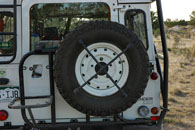
Axle & t-case oil upgraded to Royal Purple
Transmission oil upgraded to Valvoline synthetic
All wheel bearings
Brake pads
Timing belt
Serpentine belt
Engine oil
Fuel filter
Roll cage
Roof rack
Window protection
Air tank
The roll cage was powder coated when it was built, but miles in Africa had removed some of the coating. The sliders and corner protectors had been modified by SpiderTrax for the roll cage, but they had just painted the new parts and had not re-powder coated them. Also the window protection and the roof rack had just been painted as we ran out of funds and time. All of this including the air tank were removed and taken in for powder coating. Reinstalling made a world of difference and made the truck look almost new again!


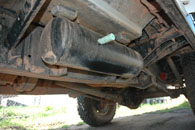
For Africa we left the 60% portion of the rear seat in the car (but folded) so we could transport additional people when we needed to. Since this happened very rarely we decided to remove the 60% part of the seat to allow more storage space. The 40% seat is still in the truck in case needed.
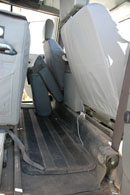
With all respect to Justin who designed and built our roof rack, it was way too heavy. I decided to cut some metal out of it to lighten the load. Ended up being 30lbs of steel lost with no effect on useful strength!
The power point on the roof rack proved to not have enough power to run the ARB Adventure light all the time. I removed the power point and am considering if it is worth redoing the wiring and putting it back.
Several places on the truck the accessory wiring was messy. Grounds didn't all go to the same place, lights were wired in series with other accessories and other badly thought-out modifications. I have tried to resolve these issues by cleaning up and simplifying the wiring.
Due to a brain-fart in Libreville I drove into a steel barrier and damaged the steering box. We were unable to replace that in Libreville and were only able to find a replacement in South Africa at a Land Rover scrap yard. We got the box there but didn't install it until we got back the US.
When purchasing the stereo from Best Buy we added the extended service option. Taking it in for service proved to be a mistake as it has not worked correctly since. I intend to replace it with something iPod friendly in Iteration 3.
The filing cabinet drawers in the rear of the car were showing the wear of all that use in Africa. We painted both the drawers and the mounts a flat black and removed the label holders. I never liked the gold color of the drawer pulls, so I insisted on painting them black as well. Unfortunately the paint doesn't stick to the gold plating too well.
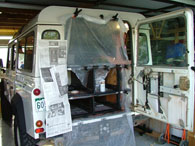
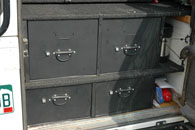
In Africa we had several problems with the Safari Gard JEK Stage II suspension.

|
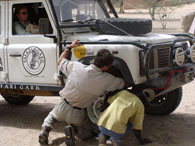
|

|
|
First suspension failure was in Niger. Seemed to just be a shock valve failure.
|
The second failure was also in Niger. This time the tower ripped off the frame. We had it welded back on.
|
In Gabon we gave up and removed the shock and the tower.
|
On the front suspension problems arose in Niger when I noticed that one of the front shocks was leaking oil out of the shrader valve. It seemed to be a clearence issue with the tower, so I installed a spare shock with no valve cap, and later removed the valve cap from the other side. More bad new came a few days later when Connie felt something hitting the floor below her feet. It turned out to be the shock tower that had ripped free of the frame. We had it welded on to the frame. Turns out that the shocks bottomed out before the bump stop hit the axle which ripped the front shock towers off the frame. In Gabon, we gave up and removed the tower and the shock, substituting a strap to act as a bottom stop. This field fix lasted until Namibia!
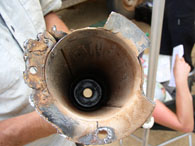
|
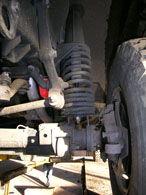
|
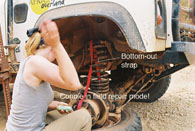
|
|
The damage to the shock tower was pretty severe!
|
The original setup reveals how the geometry was wrong.
|
Connie installing a bottom-out strap.
|
In Namibia we took a brief detour to Windhoek to visit Roverland where we were able to source Dicscovery Series II shock towers. These towers move the shock up enough to eliminate the bottoming problem. We then re-installed the shock that was taken off in Gabon. This fix proved very workable, and lasted until the end of the trip.
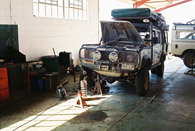
|
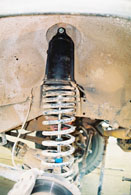
|
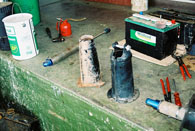
|
|
At Roverland just outside Windhoek.
|
New towers installed.
|
The surviving original tower sitting next to its replacement.
|
But improvements were still to be had! Back in Colorado, I took the truck to RoverTracks for Keith to weigh in on improvements. He supplied some new shock towers that will give me the option of going to remote reservoir shocks in the future as well as new lower shock mounts that are slightly lower profile. The towers are made out of tube, and are slightlt taller than the Discovery Series II towers. Because of the taller towers, the plastic dust covers in the wheel wells could not be used. I manufactured some new ones out of inner tube.
Safari Gard had supplied some caster corrected front radius arms that we were unable to install before we went to Africa. I installed these and fitted them with Ironman polybushings. This improved handling, but also required some work on the front prop-shaft (see that mod elsewhere).
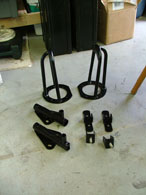
|

|
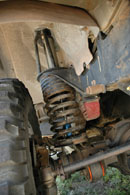
|
|
New and re-worked parts from RoverTracks get back from powercoating.
|
New towers and custom dust covers.
|
Finally the front geometry problems are solved!
|
The rear suspension had several problems in Africa. The shock mounts were too far inboard causing the shock heim joints to run out of travel. Also, the 1" spacers were slightly too small and they fatigued the spring mounts of the axle finally causing them to crack and start to tear off the axle. RoverTracks modified the Safari Gard top shock mounts to move the shock outboard about an inch so that the heim joints no longer ran out of travel. On the axle Keith repaired the lower spring mounts and machined a better 1.5" spacer out of alluminium to stop the damage from re-occurring. We removed the upper spring stay, and I welded up some dislocation guides to allow the springs to drop out of the top mount and then re-seat themselves.
So far these modifications have worked very well, and no further suspension issues have been encountered.
Due to a major brain-fart, I installed the Safari Gard tire rack incorrectly. It was adjusted such that when opened and closed it caused major stress on the upper mounting point. Eventually the fatigue took its toll on the rear bodywork and started to rip the top of the tub apart. It destroyed the capping and the rear light. I tried to re-adjust it in the Kalahari, but this was too late and the damage was already done. To stop the tire rack issue from happening again, I built a beefier internal mounting plate for the rack and added some metal to the plate on the rear door that the rack bolts to. I also tried to make sure that the rack is adjusted properly. So far so good.
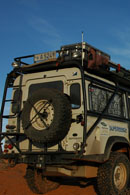
The water tap that came with the Excel tank was solid brass and a very nice unit, but had started to leak by the time we got back from Africa. I tried to repair it, but was unable to, so instead replaced it with a tap from Home Depot.

The Michelin XZL tires we used in Africa had reached the end of their service life by the time we returned. They are also very expensive and hard to replace. Since we had been running tubes with the XZLs, the wheels were for tubed tires. I purchased some tubeless wheels (also Wolf wheels and otherwise identical to the tubed wheels) and we traded with James and Angela of No Limit Expeditions for a set of 5 BF Goodrich mud terrain tires. The XZLs were 760R16s and the BFGs are 265 75R16s.

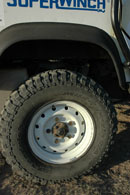
|